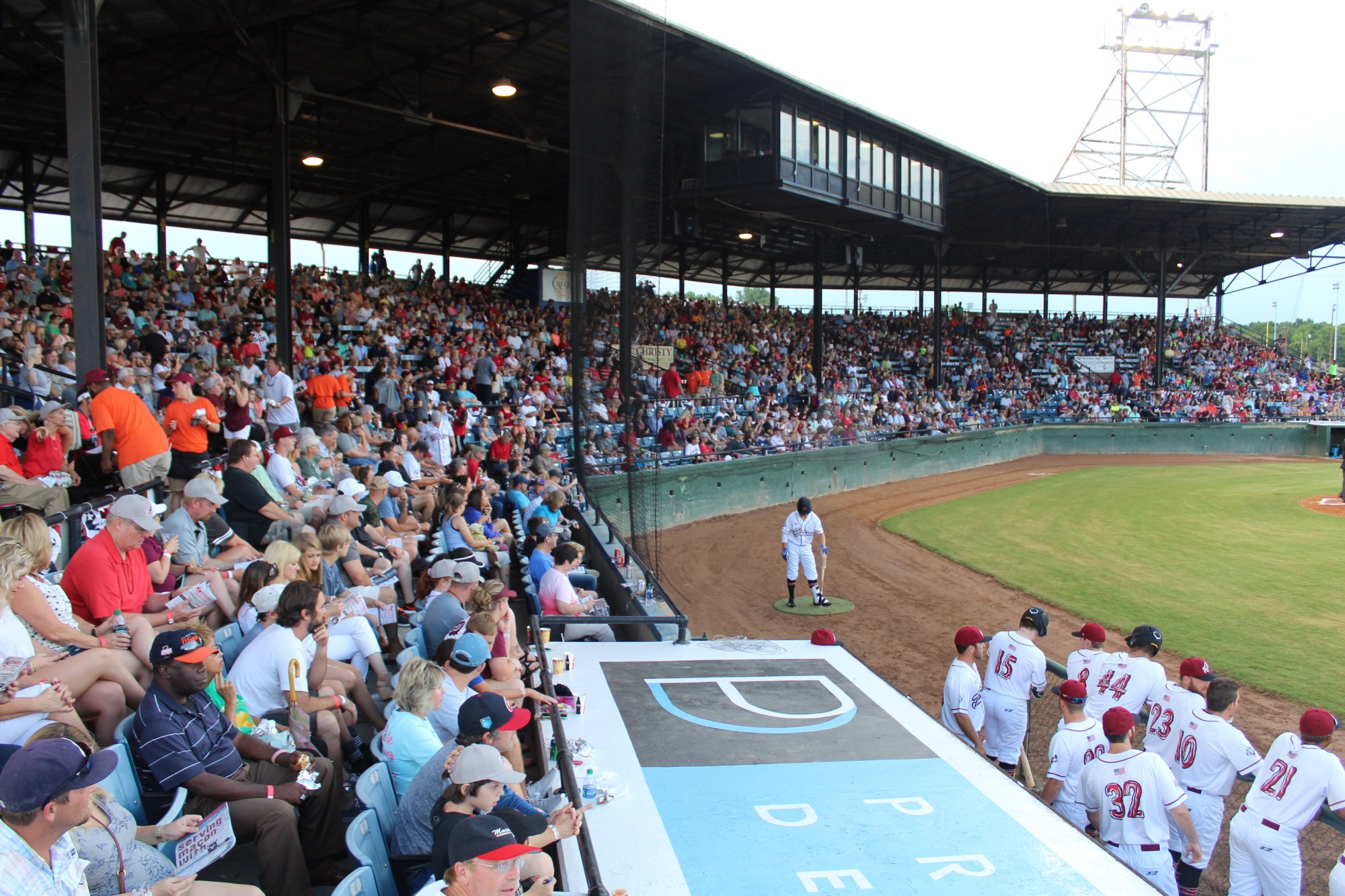With venerable Luther Williams Field debuting this season as home of the Macon Bacon, summer-collegiate baseball saw the addition of another landmark ballpark to its ranks, encapsulating America’s long love affair with the National Pastime.
With the arrival of the Bacon and the Coastal Plain League to Georgia, Luther Williams Field (above) was subjected to a modest overhaul that saw a refurbished bowl, new concessions, new cabana suites and a new party deck. Despite the improvements, the ballpark retains its original grandstand and outer wrought-iron fencing. It opened in 1929 as the home of the Macon Peaches, then a Southern League team. There’s a rich baseball history at Luther Williams Field: Many cogs in the Big Red Machine (Pete Rose, Tony Perez) played there, as did future Atlanta Braves stars like Andruw Jones, Chipper Jones and John Smoltz.
That Luther Williams Field ended up hosting summer-collegiate ball—complete with a facelift—is one of the great stories in baseball. Today, summer-collegiate baseball is the driving force behind ballpark preservation on the community level, the economic justification for communities and teams to invest in classic old ballparks. Indeed, the history of ballparks in America can be traced back from today’s summer-collegiate ballparks.
Luther Williams Field is a good example of this. Opening as Central City Park on April 18, 1929, Macon Mayor Luther Williams declared the ballpark opening a holiday and urged all Macon citizens to attend the grand opening. (Like the mayors of today, Williams pushed the ballpark as a sound economic investment for the city: “If we go wholeheartedly into and keep it up, win or lose, it will redound to the interests of all our business undertakings.”) By the end of April, the Macon City Council had launched a resolution to rename the ballpark to honor Mayor Williams. Luther Williams Field hosted Class AA and Low-A ball for decades, community baseball at its finest.
There are still older ballparks in use in Minor League Baseball, such as Asheville’s McCormick Field and Daytona Beach’s Jackie Robinson Ballpark, but these facilities have been extensively renovated and upgraded to meet modern pro-baseball standards. In summer-collegiate ball, the renovations have been less extensive, allowing old ballparks to retain much of their original charm. Wahconah Park, home of the Pittsfield (MA) Suns, opened on 1919 and hosted plenty of pro baseball over the decades while retaining the look and feel of the original. Robin Roberts Stadium, now home of the Springfield (IL) Sliders and former home to Triple-A and Low-A ball, opened in 1928 and still feels like it did when Hall of Famer Robin Roberts was a standout for local Lanphier High School.
One ballpark era, in particular, is well-represented in summer-collegiate facilities: WPA-era ballparks. In our 2018 Best of the Ballparks summer-collegiate vote, several ballparks with Works Progress Administration/Work Projects Administration ties are thriving as homes to summer-collegiate teams. The WPA was a central tool in President Franklin Roosevelt’s New Deal initiative, launched to counteract the debilitating effects of the Great Depression between 1935 and 1943. WPA spending was spread across the country. In Duluth (MN), WPA funds were used by the city to construct Wade Stadium (shown above), now the home of the Duluth Huskies. In Nashua (NH), WPA funds were used by the city to construct Historic Holman Stadium, now the home of the Nashua Silver Knights. In Newport (RI), WPA money was used to renovate and expand historic Cardines Field, now home of the Newport Gulls, which first opened in 1908 to host industrial-league and amateur play. In Eau Claire (WI), St. Joseph (MO), Hannibal (MO) and Wausau (WI), the WPA oversaw ballpark construction, directly employing workers and, in the case of Hannibal and Eau Claire, using the same blueprints to build Clemens Field and Carson Park, respectively.
In fact, every era of baseball—pro and amateur—is represented in summer-collegiate baseball. Post-war optimism and the expansion of Minor League Baseball is well-represented by Danville Stadium, home of the Danville (IL) Dans. Industrial-league and wartime All-American Girls Professional Baseball League baseball are represented by Simmons Field, home of the Kenosha (WI) Kingfish. Ballparks like Warner Park (Madison Mallards) and Witter Field (Wisconsin Rapids Rafters) have their roots in Minor League Baseball in Wisconsin. And, in a tribute to the importance of today’s summer-collegiate industry, you have new ballparks like Kapco Park, home of the Lakeshore (WI) Chinooks, and Kokomo Municipal Stadium, home of the Kokomo (IN) Jackrabbits.
We are in the midst of the summer-collegiate season, which ends in late July and early August for many leagues. In many communities, summer-collegiate baseball is a wonderful way to reconnect with baseball history. Take a minute to participate in our 2018 Best of the Ballparks summer-collegiate vote and reflect on the rich traditions in the 32 finalists.
Photo of Luther Williams Field courtesy Macon Bacon.
This article first appeared in the Ballpark Digest newsletter. Are you a subscriber? It’s free, and you’ll see features like this before they appear on the Web. Go here to subscribe to the Ballpark Digest newsletter.



